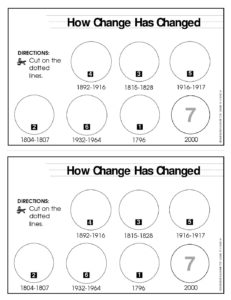Summary
Students will create a timeline to show the sequence of change that the "tails" side of a quarter has gone through.
Objectives
Students will create a timeline to show the sequence of change that the "tails" side of a quarter has gone through.
Subject Area
- Coins & Mint
- History & Government
- Math
Grades
- K
- 1st
Class Time
- Total Time: 0-45 Minutes minutes
Materials
- "How Change Has Changed" worksheets, one per student
- Why Money Was Invented 4 by Neale S. Godfrey (read aloud link: https://www.youtube.com/watch?v=EfMdCD1FNDY)
- Scissors
- Glue
- Chart paper
- Markers
Lesson Steps
- Focus on the objective by asking: "Who can tell me something that they know of that has changed?" (Possible responses: babies to adults, puppies to dogs, tadpoles to frogs, caterpillars to butterflies.) List responses on chart paper.
- Explain that many things change naturally over time, such as people, animals, and insects.
- Discuss other changes of things from the past to the present, such as transportation and technology.
- Review the story, Why Money Was Invented 4, by Neale S. Godfrey. Discuss how our money system has changed over time.
- Explain that the design of the quarters has changed a lot since 1796. Tell students that they will be making their own timeline to show some of the changes that the "tails" of quarters have been through from 1796 until now.
- Distribute the "How Change Has Changed" worksheet and a copy of the 2000 quarters.
- Have students cut out all the coins on the "How Change Has Changed" worksheet. Ask students to pick their favorite 2000 quarter and cut it out from the sheet provided.
- Supply students with the "How Change Has Changed" timeline. Ask them to glue each quarter in correct sequence. Spaces #1-6 are filled with quarters from the "How Change Has Changed" worksheet. Students should glue their favorite 2000 quarter in space #7.
Assess
Use the worksheets and class participation to assess whether the students have met the lesson objectives.
Common Core Standards
This lesson plan is not associated with any Common Core Standards.
National Standards
Discipline: Mathematics
Domain: All Problem Solving
Cluster: Instructional programs from kindergarten through grade 12 should enable all students to
Grade(s): Grades K–12
Standards:
Discipline: Visual Arts and Music Domain: K-4 Visual Arts Cluster: Standard 6: Making connections between visual arts and other disciplines Grade(s): Grades K–12 Standards:
Discipline: Mathematics Domain: All Communication Cluster: Instructional programs from kindergarten through grade 12 should enable all students to Grade(s): Grades K–12 Standards:
- Build new mathematical knowledge through problem solving
- Solve problems that arise in mathematics and in other contexts
- Apply and adapt a variety of appropriate strategies to solve problems
- Monitor and reflect on the process of mathematical problem solving
Discipline: Visual Arts and Music Domain: K-4 Visual Arts Cluster: Standard 6: Making connections between visual arts and other disciplines Grade(s): Grades K–12 Standards:
- Students understand and use similarities and differences between characteristics of the visual arts and other arts disciplines
- Students identify connections between the visual arts and other disciplines in the curriculum
Discipline: Mathematics Domain: All Communication Cluster: Instructional programs from kindergarten through grade 12 should enable all students to Grade(s): Grades K–12 Standards:
- organize and consolidate their mathematical thinking through communication
- communicate their mathematical thinking coherently and clearly to peers, teachers, and others;
- analyze and evaluate the mathematical thinking and strategies of others; and
- use the language of mathematics to express mathematical ideas precisely.
Subscribe to our
Lessons that Make Cents newsletter.

